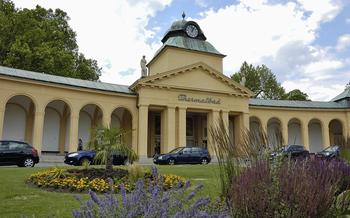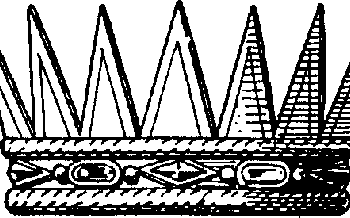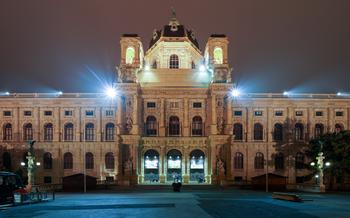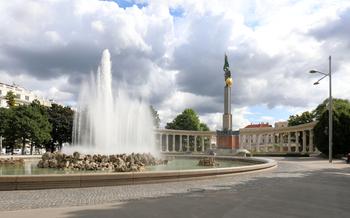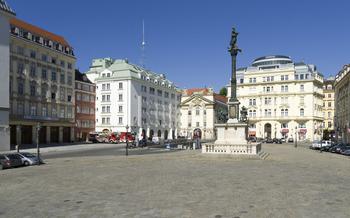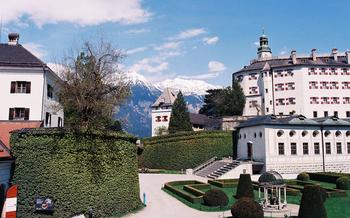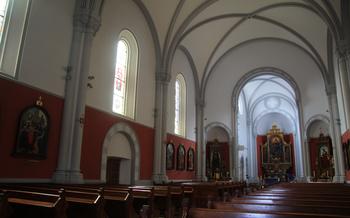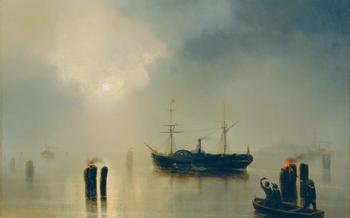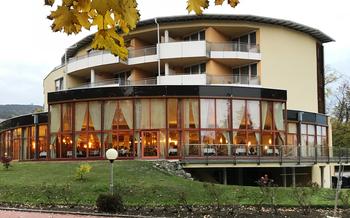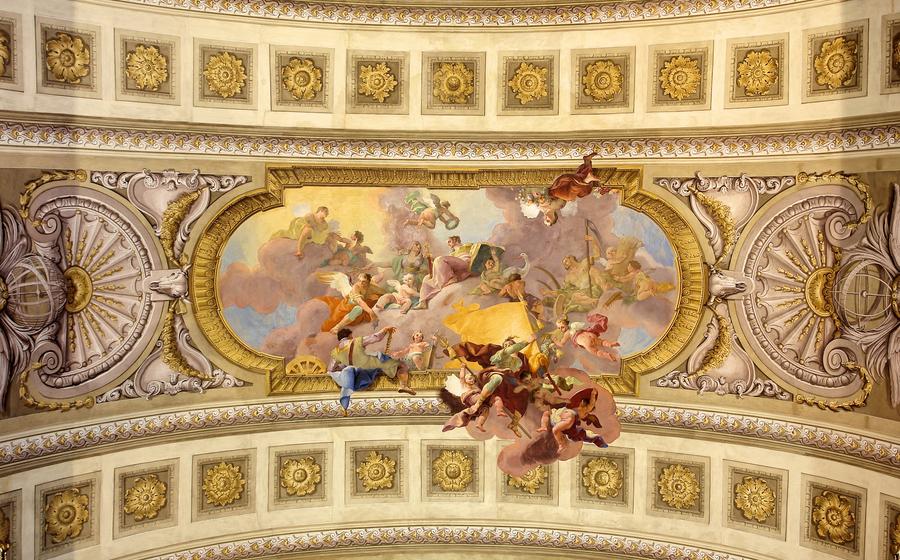
Austrian National Library
- A Journey Through History
- Unveiling the Baroque Masterpiece
- Exploring the Imperial Library
- The World's Largest Globe
- Music Collection
- Map Collection
- Papyrus Collection
- Literary Treasures
- Special Collections
- Research Facilities
- Visitor Information
- Insider Tip
A Journey Through History
Witness the grandeur of Austria's rich history at the Austrian National Library in Vienna. This cultural institution, nestled within the heart of the Hofburg Palace complex, offers a journey through time with its impressive collections, guided tours, and captivating temporary exhibitions.
Delve into the library's treasure trove of over 12 million books, manuscripts, and maps, some dating back to the Middle Ages. As you wander through the majestic halls, admire the architectural masterpieces that complement the remarkable collection. From the awe-inspiring ceiling frescoes to the intricate marble statues, each corner of the library is a testament to the Habsburg dynasty's patronage of the arts and sciences.
Immerse yourself in the history of the library and its unique collections through guided tours. Knowledgeable guides will take you on a journey through the centuries, sharing fascinating stories and insights into the treasures that have been preserved within these walls.
Don't miss the opportunity to explore the temporary exhibitions that showcase special collections and themes. These exhibitions provide a glimpse into the diverse cultural heritage of Austria and the world, offering a fresh perspective on the library's vast holdings.
Unveiling the Baroque Masterpiece
The Austrian National Library is not just a treasure trove of books and manuscripts; it is also a stunning work of art. The library's building, constructed in the 18th century, is a masterpiece of Baroque architecture. Its exterior is adorned with intricate sculptures and carvings, while its interior features soaring ceilings, marble statues, and a magnificent domed reading room.
At the heart of the library lies the State Hall, the largest and most impressive room in the building. This opulent hall is lined with floor-to-ceiling bookshelves, each filled with rare and valuable volumes. The ceiling is adorned with stunning frescoes by Daniel Gran, depicting scenes from Austrian history and mythology.
The library also features a number of other impressive rooms, including the Marble Hall, the Globe Hall, and the Music Collection. The Marble Hall is home to a collection of exquisite marble statues, while the Globe Hall features a giant globe that was commissioned by Emperor Charles VI in the 18th century. The Music Collection houses a vast collection of musical scores, manuscripts, and instruments, making it a paradise for music lovers.
Exploring the Imperial Library
The Austrian National Library is deeply entwined with the Habsburg Dynasty, which ruled over Austria for over six centuries. The Habsburgs were renowned for their patronage of the arts and sciences, and they amassed an impressive collection of books and manuscripts. In the 15th century, Emperor Frederick III founded the Imperial Library, which was initially housed in the Hofburg Palace. Over the centuries, the collection grew significantly, and in the 19th century, it was moved to its current location in the Neue Burg wing of the Hofburg Palace.
The Imperial Library is a treasure trove of rare and valuable books and manuscripts. It houses over 200,000 volumes, including many first editions and illuminated manuscripts. Among the highlights of the collection are the "Codex Vindobonensis," a 6th-century manuscript of the Bible; the "Tabula Peutingeriana," a 13th-century map of the Roman Empire; and the "Ambras Songbook," a 16th-century collection of songs and dances.
The Imperial Library is a must-see for anyone interested in history, literature, or the arts. It is a place where visitors can explore the rich cultural heritage of Austria and marvel at the beauty and diversity of the written word.
The World's Largest Globe
Among the many treasures housed within the Austrian National Library, one cannot fail to be captivated by the world's largest globe. Created in 1717 by the renowned cartographer Vincenzo Coronelli, this awe-inspiring globe stands at an astonishing 11 feet in diameter, making it a true marvel of craftsmanship and scientific achievement.
The globe, known as the "Erdapfel" (Earth Apple), is a testament to the meticulous precision and artistic flair of Coronelli. Its surface is meticulously adorned with intricate details, depicting continents, oceans, and even the smallest of islands with remarkable accuracy. The vibrant colors and delicate brushstrokes bring the world to life, inviting viewers to embark on a captivating journey of exploration.
Coronelli's celestial map, displayed alongside the globe, offers an equally breathtaking spectacle. This celestial globe, crafted with the same precision and artistry as its terrestrial counterpart, showcases the constellations and celestial bodies that grace the night sky. The intricate details and vibrant colors transport viewers to the vast expanse of the universe, inspiring a sense of wonder and awe.
Beyond its artistic and scientific significance, the world's largest globe holds immense historical value. It represents a pivotal moment in cartography, serving as a symbol of the enlightenment and the pursuit of knowledge that defined the 18th century. Coronelli's masterpiece stands as a testament to the enduring human fascination with the world around us and our insatiable desire to explore and understand the mysteries that lie beyond.
Music Collection
The Austrian National Library is home to an extensive music collection that is considered one of the most significant in the world. It encompasses over a million musical items, including handwritten scores, first editions, printed music, and music instruments.
The collection boasts works by some of the greatest composers in history, including Mozart, Beethoven, Schubert, and Brahms. Visitors can marvel at original manuscripts of iconic compositions, such as Mozart's "Don Giovanni" and Beethoven's "Ninth Symphony".
The library also houses a vast collection of first editions of musical works, dating from the 16th century to the present day. These include rare editions of operas, symphonies, and chamber music by composers from all over the world.
The music collection is not just limited to classical music. It also encompasses a wide range of other genres, including jazz, folk, and contemporary music. Visitors can explore the library's extensive collection of recordings, which includes both historical and modern performances.
The Austrian National Library offers a variety of ways for visitors to engage with its music collection. Guided tours are available, allowing visitors to learn more about the collection's highlights and see some of the rare items up close. The library also hosts regular concerts, lectures, and workshops related to music.
Map Collection
The Austrian National Library is home to an impressive map collection with over 200,000 historical maps, making it one of the largest and most significant cartographic collections in the world. The collection includes maps dating from the 15th to the 21st century, covering various regions, including Europe, Asia, Africa, and the Americas.
One of the highlights of the collection is the Tabula Peutingeriana, a 13th-century Roman road map that depicts the entire Roman Empire. Another notable map is the Portolan Atlas, a 16th-century atlas of the Mediterranean Sea, which was used by sailors and merchants for navigation.
The map collection also contains a large number of city plans, including a detailed plan of Vienna from 1760, which provides a fascinating glimpse into the city's past. The maps are a valuable resource for historians, geographers, and anyone interested in the history of cartography.
Tip: Don't miss the globe collection, which includes a stunning 3-D globe of the world from the 17th century.
Papyrus Collection
The Austrian National Library houses an impressive papyrus collection, making it one of the most significant in the world. These ancient Egyptian papyri offer a glimpse into the rich history and culture of ancient Egypt. The collection encompasses a wide range of documents, including religious texts, literary works, administrative records, and personal letters.
One of the highlights of the papyrus collection is the Papyrus Erzherzog Rainer, which dates back to the 13th century BC. It contains a remarkable collection of hieratic texts, including religious hymns and magical spells. Another notable papyrus is the Papyrus Ebers, which is a medical papyrus that dates back to the 16th century BC. It contains over 700 remedies for various diseases and ailments.
The papyrus collection also includes a number of Demotic papyri, which were written in a script that was used in ancient Egypt from the 7th century BC to the 5th century AD. These papyri provide valuable insights into the everyday lives of ancient Egyptians, as they often contain personal letters, contracts, and legal documents.
The Austrian National Library's papyrus collection is a treasure trove of ancient Egyptian history and culture. It offers visitors the opportunity to learn about the daily lives, beliefs, and practices of the ancient Egyptians, and to marvel at the remarkable preservation of these fragile documents.
Literary Treasures
Among the millions of volumes housed within the Austrian National Library, a trove of literary treasures awaits discovery. Rare books, first editions, illustrated manuscripts, and autographs from renowned authors grace the shelves, inviting visitors to delve into the world of literature. From medieval manuscripts adorned with intricate illuminations to first editions of classic works, the library's collection spans centuries and genres, offering a glimpse into the evolution of literary expression. Autographed manuscripts by literary giants such as Goethe, Schiller, and Kafka provide a tangible connection to these celebrated figures, allowing visitors to appreciate their genius up close.
Special Collections
Beyond its vast collection of books and manuscripts, the Austrian National Library is home to a treasure trove of special collections that offer a glimpse into diverse fields of knowledge and human creativity. Among these collections, visitors can explore:
-
Children's books collection: Delve into the enchanting world of children's literature through a collection that spans centuries and includes rare editions, illustrated manuscripts, and beloved classics.
-
Theatrical collection: Discover the rich history of theater and performing arts through a collection of playbills, scripts, costumes, and set designs, providing insights into the evolution of theatrical productions.
-
Cookbooks collection: Explore the culinary heritage of Austria and beyond through a collection of cookbooks dating back to the 16th century, offering a glimpse into historical recipes, cooking techniques, and culinary traditions.
-
Travel literature collection: Embark on a journey through the written accounts of travelers and explorers from around the world, providing insights into historical journeys, cultural encounters, and the evolution of travel writing.
Research Facilities
The Austrian National Library provides a comprehensive range of research facilities to cater to the needs of scholars, students, and researchers. Reading rooms are available throughout the library, offering quiet and comfortable spaces for studying and research. The library's reference services are staffed by experienced librarians who can assist researchers in finding the materials they need and answer any questions they may have. The library also offers interlibrary loan services, allowing researchers to borrow materials from other libraries around the world. In addition, the library has a wealth of digital resources, including online databases, e-books, and digitized manuscripts, which can be accessed remotely by researchers around the world.
Visitor Information
Opening Hours The Austrian National Library is open to the public from Tuesday to Sunday, from 9am to 7pm. It is closed on Mondays and public holidays.
Admission Fees Admission to the library is free of charge. However, there may be a fee for special exhibitions or events.
Guided Tours Guided tours of the library are available in English, German, and other languages upon request. Tours must be booked in advance and cost €5 per person.
Accessibility The library is wheelchair accessible and offers a variety of services for visitors with disabilities, including ramps, elevators, and accessible restrooms.
Remember, it's always a good idea to check the library's website for the most up-to-date information on hours, fees, and events.
Insider Tip
To fully immerse yourself in the grandeur of the Austrian National Library and avoid the hustle and bustle of large crowds, plan your visit strategically. Opt for the tranquility of off-peak hours or weekdays, when you'll have ample space to explore the vast collections and admire the architectural details without feeling rushed.
Take advantage of the complimentary guided tours offered by the library, which provide an insightful journey through its history, collections, and architectural highlights. These tours are led by knowledgeable guides who will captivate you with stories and anecdotes, ensuring a truly enriching experience.
Don't miss the opportunity to ascend to the rooftop terrace, which offers breathtaking panoramic views of the city and its iconic landmarks. Marvel at the stunning vistas as you soak up the atmosphere of this historic institution.
Combine your visit to the library with a leisurely stroll through the picturesque gardens of the Hofburg Palace, which are just a stone's throw away. These serene gardens provide a tranquil oasis amidst the vibrant city, inviting you to unwind and savor the beauty of your surroundings.
